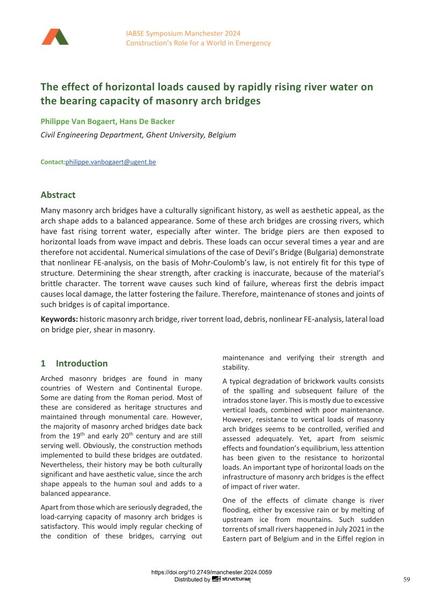The effect of horizontal loads caused by rapidly rising river water on the bearing capacity of masonry arch bridges

|
|
|||||||||||
Bibliografische Angaben
| Autor(en): |
Philippe Van Bogaert
(Civil Engineering Department, Ghent University, Belgium)
Hans De Backer (Civil Engineering Department, Ghent University, Belgium) |
||||
|---|---|---|---|---|---|
| Medium: | Tagungsbeitrag | ||||
| Sprache(n): | Englisch | ||||
| Tagung: | IABSE Symposium: Construction’s Role for a World in Emergency, Manchester, United Kingdom, 10-14 April 2024 | ||||
| Veröffentlicht in: | IABSE Symposium Manchester 2024 | ||||
|
|||||
| Seite(n): | 59-66 | ||||
| Anzahl der Seiten (im PDF): | 8 | ||||
| DOI: | 10.2749/manchester.2024.0059 | ||||
| Abstrakt: |
Many masonry arch bridges have a culturally significant history, as well as aesthetic appeal, as the arch shape adds to a balanced appearance. Some of these arch bridges are crossing rivers, which have fast rising torrent water, especially after winter. The bridge piers are then exposed to horizontal loads from wave impact and debris. These loads can occur several times a year and are therefore not accidental. Numerical simulations of the case of Devil’s Bridge (Bulgaria) demonstrate that nonlinear FE-analysis, on the basis of Mohr-Coulomb’s law, is not entirely fit for this type of structure. Determining the shear strength, after cracking is inaccurate, because of the material’s brittle character. The torrent wave causes such kind of failure, whereas first the debris impact causes local damage, the latter fostering the failure. Therefore, maintenance of stones and joints of such bridges is of capital importance. |
||||
